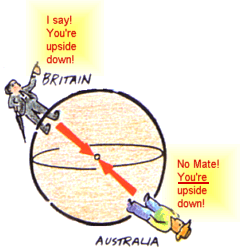
We can't actually see forces, but we see their effect
on objects. We see the Moon orbit the Earth, objects fall to the ground,
and birds fly - all of these are because of forces.
|
1 Newton isn't
a very big force: it's about the weight of an apple. |
| Forces can change:- |
|
|
Gravity This means that, wherever you are in the world, "down" is always towards the ground - even though your "down" isn't the same direction as anybody else's. The gravitational
pull of the Earth is what gives objects weight. The Earth pulls
on every kilogramme with a force of ten Newtons. |
|
|
Gravity
is a very weak force, you need a very large mass in order
to get a noticeable gravitational pull. |
|
|
|
|
Sir Isaac Newton came up with three "Laws of Motion" back in the 17th century, which we still find useful today. For the moment, we need:-
 |
Newton's First
Law, says that if the forces on an object are in balance, the object's speed and direction of motion won't change. (In other words, if you leave it alone, it'll carry on doing whatever it was doing already.) If the forces on an object are in balance, then the object's velocity is constant.This means that if it's not moving, it'll stay still; or if it is moving, it'll continue in a straight line at a constant speed . What if the forces aren't in balance? See Acceleration page |
Here is a picture
of a parchustist, descending at a constant speed.
Click on the picture to see the answer |
 |
|
When several forces act on an object, we can add them together to find out what's going to happen. The combined effect of all the forces on an object is called the resultant force. For
GCSE, you'll usually only be asked to deal with forces which are
all in a straight line. Question:
if I push a car with a force of 500N, and somebody else pushes the
other way with a force of 400N, what is the resultant force on the
car? |
If these pictures aren't moving, click
on "Refresh"/"Reload"
|
   |
|
Advanced: |
If the forces are not in a straight line, we must use other techniques, such as a "triangle of forces", to find the resultant. If
this picture isn't moving, click on
"Refresh"/"Reload"
|
 |
Newton's Third
Law,
says that every action has an equal and opposite reaction. In other words, when you push or pull something, it pushes or pulls back at you. Forces are two-way affairs, they're about the way that objects affect each other. For example,
you're pushing down on your chair with a force of, maybe,
500N, and the chair is pushing back with a force of 500N. |
